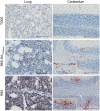Highly pathogenic H5N1 influenza viruses carry virulence determinants beyond the polybasic hemagglutinin cleavage site
- PMID: 20676399
- PMCID: PMC2910732
- DOI: 10.1371/journal.pone.0011826
Highly pathogenic H5N1 influenza viruses carry virulence determinants beyond the polybasic hemagglutinin cleavage site
Abstract
Highly pathogenic avian influenza viruses (HPAIV) originate from avirulent precursors but differ from all other influenza viruses by the presence of a polybasic cleavage site in their hemagglutinins (HA) of subtype H5 or H7. In this study, we investigated the ability of a low-pathogenic avian H5N1 strain to transform into an HPAIV. Using reverse genetics, we replaced the monobasic HA cleavage site of the low-pathogenic strain A/Teal/Germany/Wv632/2005 (H5N1) (TG05) by a polybasic motif from an HPAIV (TG05(poly)). To elucidate the virulence potential of all viral genes of HPAIV, we generated two reassortants carrying the HA from the HPAIV A/Swan/Germany/R65/06 (H5N1) (R65) plus the remaining genes from TG05 (TG05-HA(R65)) or in reversed composition the mutated TG05 HA plus the R65 genes (R65-HA(TG05poly)). In vitro, TG05(poly) and both reassortants were able to replicate without the addition of trypsin, which is characteristic for HPAIV. Moreover, in contrast to avirulent TG05, the variants TG05(poly), TG05-HA(R65), and R65-HA(TG05poly) are pathogenic in chicken to an increasing degree. Whereas the HA cleavage site mutant TG05(poly) led to temporary non-lethal disease in all animals, the reassortant TG05-HA(R65) caused death in 3 of 10 animals. Furthermore, the reassortant R65-HA(TG05poly) displayed the highest lethality as 8 of 10 chickens died, resembling "natural" HPAIV strains. Taken together, acquisition of a polybasic HA cleavage site is only one necessary step for evolution of low-pathogenic H5N1 strains into HPAIV. However, these low-pathogenic strains may already have cryptic virulence potential. Moreover, besides the polybasic cleavage site, the additional virulence determinants of H5N1 HPAIV are located within the HA itself and in other viral proteins.
Conflict of interest statement
Figures





References
-
- Schaefer W. Vergleichende seroimmunologische Untersuchungen über die Viren der Influenza und der klassischen Geflügelpest. Z Naturforsch. 1955;10b:81–91.
-
- Swayne DE. Understanding the complex pathobiology of high pathogenicity avian influenza viruses in birds. Avian Dis. 2007;51:242–249. - PubMed
-
- Garten W, Klenk HD. Understanding influenza virus pathogenicity. Trends Microbiol. 1999;7:99–100. - PubMed
Publication types
MeSH terms
Substances
LinkOut - more resources
Full Text Sources
Other Literature Sources
Medical

